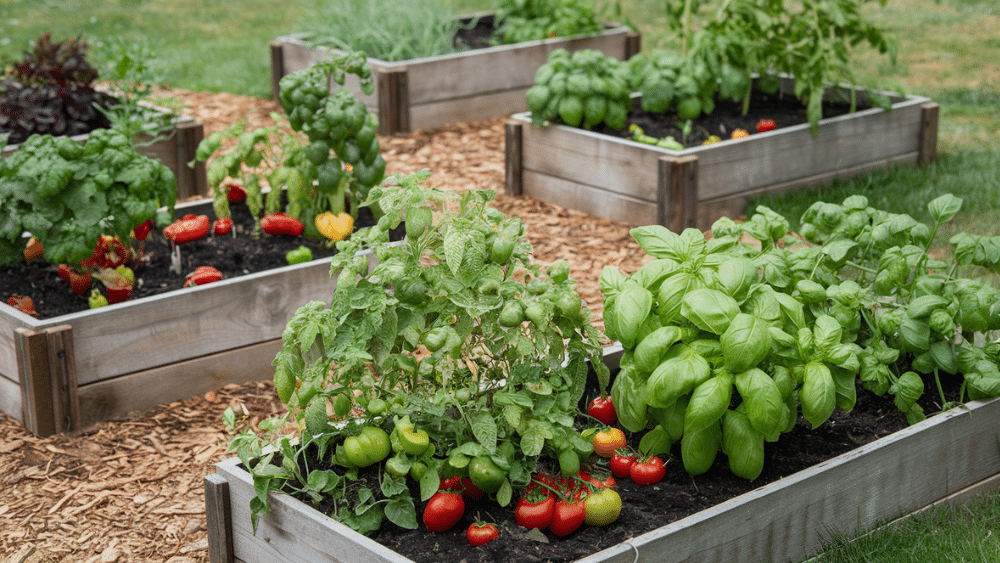Staring at your empty raised bed boxes, wondering what goes inside? You’re not alone. Many gardeners build beautiful raised beds only to feel overwhelmed by the countless soil mix options at the garden center.
Getting the fill wrong means poor drainage, stunted plant growth, and wasted money on materials that don’t work. Some gardeners spend hundreds of dollars on the wrong soil combinations, then watch their plants struggle or die.
The right raised bed fill creates the perfect environment for healthy roots, proper drainage, and abundant harvests. Your plants will thrive when you understand which materials work best together.
This guide breaks down exactly what to put in your raised beds, from bottom to top. You’ll learn the proven layering methods, cost-effective material options, and mixing ratios that successful gardeners use to create thriving garden beds.
Why the Fill Material Matters?
The materials you choose for your raised beds directly control how well water moves through the soil, how easily roots can spread, and whether your plants stay healthy or struggle to survive.
Poor drainage from heavy clay-based fills leads to root rot, while sandy mixes drain too fast and leave plants thirsty.
- Drainage affects everything: Water that sits too long kills roots, while soil that drains too fast starves plants of moisture and nutrients.
- Root development depends on texture: Compacted or heavy soils block root growth, limiting how much nutrition plants can access.
- Initial investment pays off: Quality materials cost more upfront but last longer and produce better harvests than cheap alternatives.
Quality fill materials cost more upfront but save money over time because they don’t compact, need less replacement, and produce better harvests that justify the investment.
Unlike in-ground gardening, where you work with existing soil, raised beds give you complete control over the growing environment, but this means every layer matters. Getting the fill right makes gardening easier and more successful.
Core Components of Raised Bed Fill
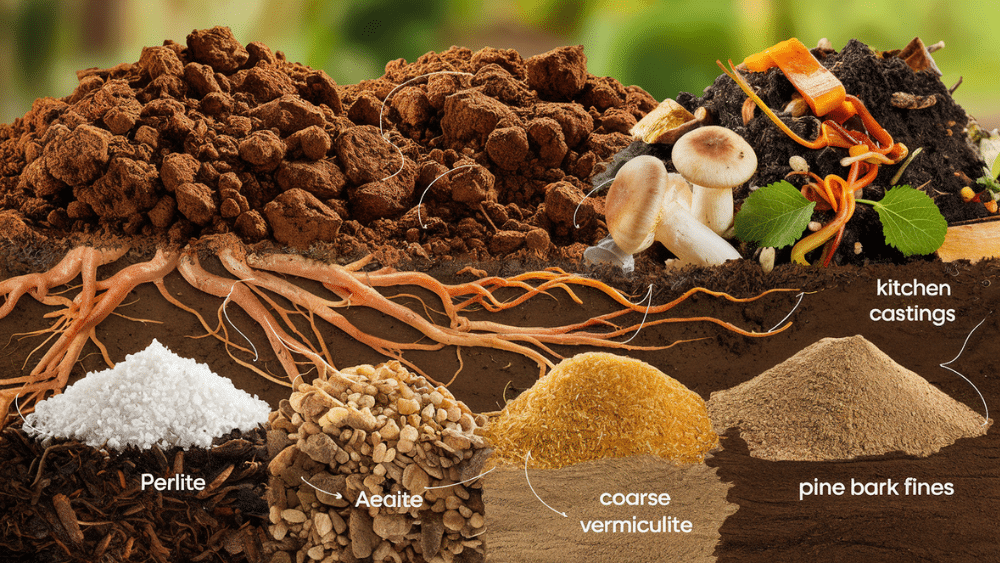
1. Topsoil
Topsoil provides the basic structure plants need to grow. Look for screened topsoil that feels crumbly, smells earthy, and appears dark brown or black.
- Quality indicators: Good topsoil feels loose in your hands and contains visible pieces of organic matter.
- Common problems: Many store-bought topsoils contain too much clay or lack proper drainage.
Quality topsoil holds nutrients and gives roots stability, but it often lacks proper drainage and can become compacted. Most commercial topsoils are low in active nutrients and may contain clay that becomes hard or muddy.
2. Compost
Compost adds nutrients and improves soil structure by helping it hold both water and air. This organic matter feeds beneficial bacteria that keep the soil healthy.
- Best moisture balance: Compost helps soil hold water during dry spells while preventing waterlogging during heavy rain.
- Nutrient release: Well-aged compost releases nutrients slowly over months, reducing the need for frequent fertilizing.
Kitchen waste compost provides rich, dark material full of nutrients. Worm castings offer slow-release nutrition without burning roots. Mushroom compost retains water well and contains balanced nutrients, though it can be slightly alkaline.
3. Aeration Materials
These materials create air pockets for drainage and root breathing.
- Permanent vs. temporary: Perlite and coarse sand last for years, while pine bark fines break down and need replacement.
- Water balance: Good aeration materials drain excess water quickly while still holding enough moisture for plant roots.
Perlite is lightweight volcanic glass that provides permanent drainage improvement. Vermiculite holds moisture while improving aeration. Coarse sand adds drainage without compacting, but avoid fine or beach sand. Pine bark fines decompose slowly while improving drainage and adding organic matter.
Popular Raised Bed Soil Mixes
These proven formulas take the guesswork out of creating healthy soil for your raised beds.
1. The “Mel’s Mix” Formula
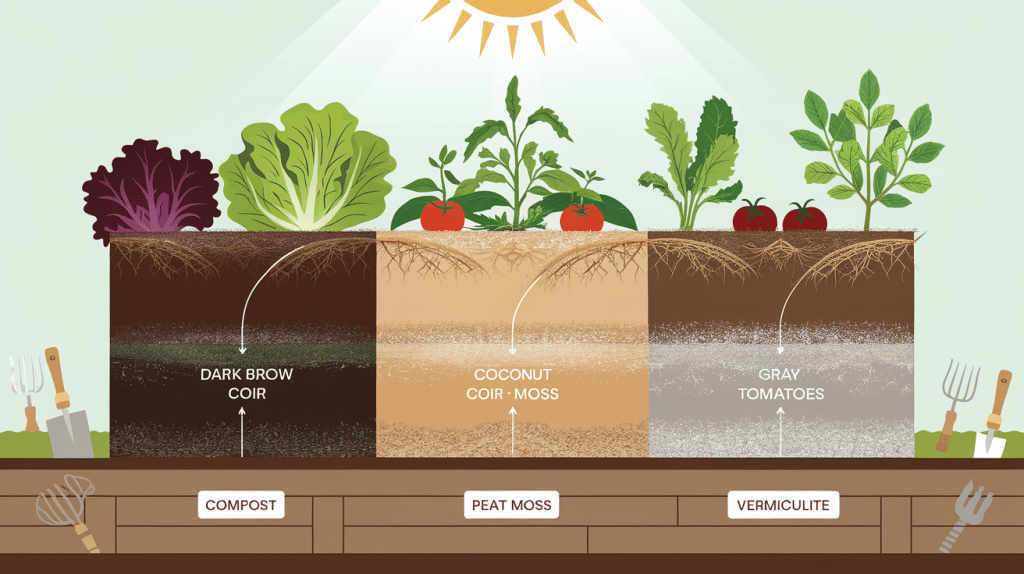
This famous square foot gardening mix combines equal parts peat moss (or coconut coir), compost, and vermiculite. The formula creates light, well-draining soil that holds nutrients and moisture without becoming waterlogged.
- Perfect balance: Each ingredient serves a specific purpose – peat retains moisture, compost feeds plants, vermiculite improves drainage.
- Great for beginners: Simple three-ingredient recipe that works for most vegetables and herbs.
- Long-lasting: This mix stays loose and doesn’t compact like regular soil.
Remember: Coconut coir works better than peat moss because it’s more sustainable and doesn’t make soil acidic.
2. Lasagna Layering Method (Hugelkultur-style)
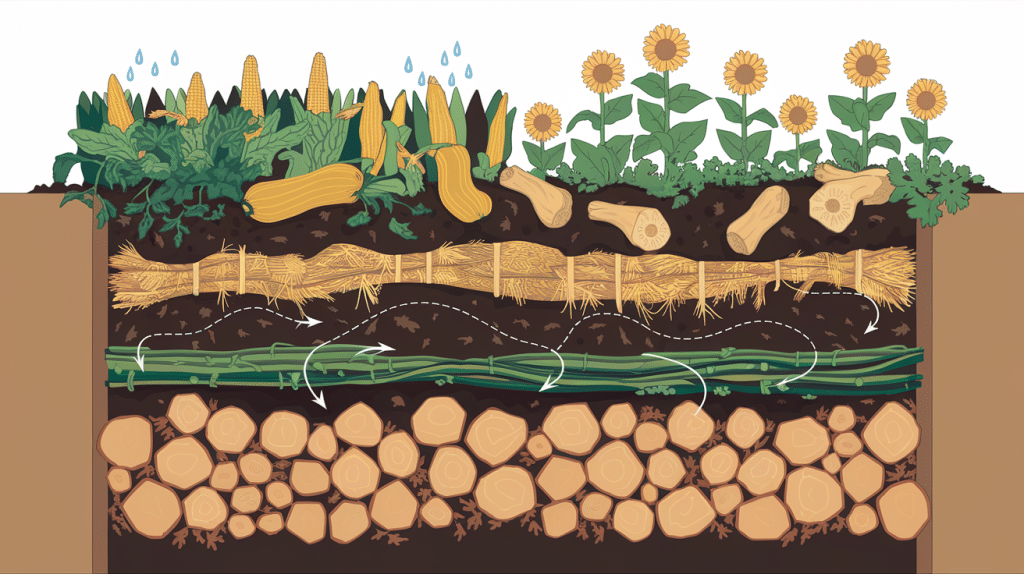
This method layers organic materials like logs, branches, straw, leaves, and compost to create rich soil over time. The bottom materials decompose slowly, feeding plants for years while improving soil structure.
- Self-feeding system: Decomposing wood and organic matter release nutrients gradually.
- Water retention: Buried logs act like sponges, storing water for dry periods.
- Perfect for deep beds: Works best in beds 18 inches deep or more.
Remember: Start this method in fall so materials have time to begin breaking down before spring planting.
3. Simple Budget-Friendly Mix
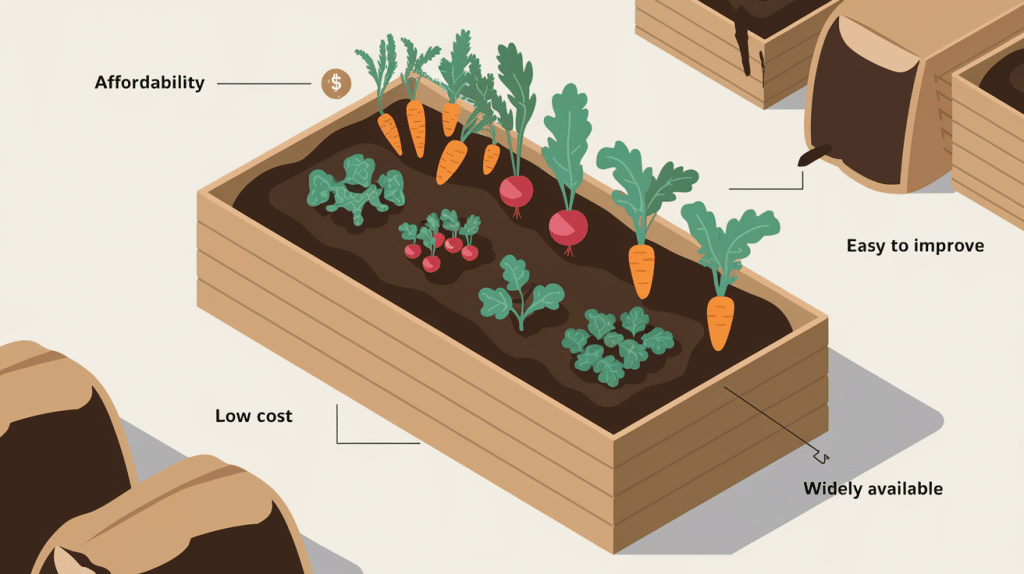
This basic combination uses quality topsoil mixed with compost in a 2:1 or 3:1 ratio. While simple, this mix provides a solid foundation that you can improve each season.
- Low upfront cost: Uses fewer ingredients than complex mixes but still grows healthy plants.
- Easy to improve: Add more compost, worm castings, or organic matter each growing season.
- Widely available: Most garden centers carry both topsoil and compost year-round.
Remember: Buy the best quality topsoil and compost you can afford – cheap materials often contain clay, weeds, or poor nutrients.
Seasonal Raised Bed Fill Maintenance Tips
1. Spring enrichment: Add 2-3 inches of fresh compost to the top of your raised beds before planting to replace nutrients used by last year’s crops and improve soil structure for the growing season.
2. Summer moisture retention: Apply a 2-4 inch layer of organic mulch like straw, shredded leaves, or wood chips around plants to keep soil cool, reduce watering needs, and prevent weeds from competing with your vegetables.
3. Fall preparation: Mix chopped leaves, kitchen scraps, or aged manure into the top 6 inches of soil so these materials can decompose slowly over winter and feed next year’s plants.
4. Winter protection: Cover beds with tarps or thick mulch layers to prevent soil erosion from rain and snow while keeping beneficial microorganisms active in the soil.
5. Year-round monitoring: Check soil moisture levels regularly since raised beds drain faster than ground soil, and add organic matter whenever the soil level drops from natural settling and decomposition.
Troubleshooting Common Raised Bed Fill Problems
- Poor drainage signs and fixes: If water pools on the surface or soil stays soggy for days, mix in coarse sand, perlite, or pine bark fines to improve water flow, and check if your bed needs drainage holes in the bottom.
- Compacted soil solutions: When soil becomes hard and difficult to dig, add compost and vermiculite to loosen the texture, avoid walking on wet soil, and use a garden fork to gently break up compacted areas without damaging plant roots.
- Nutrient deficiency identification: Yellow leaves often indicate nitrogen shortage, purple stems suggest phosphorus problems, and brown leaf edges typically mean potassium deficiency, each requiring different organic fertilizers or compost additions.
- pH imbalance correction: Test the soil pH yearly, as raised bed fill can become too acidic or alkaline over time. Then, add lime to raise the pH or sulfur to lower it, keeping most vegetables happy in the 6.0-7.0 range.
- Soil level dropping: When your raised bed fill settles and shrinks over time, top-dress with a mixture of compost and topsoil to maintain proper depth for plant roots and prevent water from pooling at bed edges.
Conclusion
Filling your raised beds correctly sets the foundation for years of successful gardening.
The right mix of topsoil, compost, and aeration materials creates the perfect environment where plants can thrive, roots can spread easily, and water drains properly without washing away nutrients.
Remember that great raised bed fill doesn’t happen overnight.
Start with a solid base using one of the proven formulas we covered, then improve your soil each season by adding compost and organic matter. Your plants will reward you with healthier growth and better harvests.
Ready to fill your raised beds? Start with the simple budget-friendly mix if you’re new to gardening, or try Mel’s Mix for proven results. What questions do you have about creating the perfect raised bed fill? Share your experiences in the comments below.

